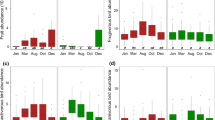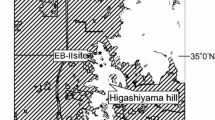Abstract
We document patterns of fruit and vertebrate abundance within an extensive, virtually undisturbed mosaic of seasonally flooded (várzea and igapó) and unflooded (terra firme) forests of central Amazonia. Using phenological surveys and a standardised series of line-transect censuses we investigate the spatial and temporal patterns of immature and mature fruit availability and how this may affect patterns of habitat use by vertebrates in the landscape. All habitats showed marked peaks in fruiting activity, and vertebrate detection rates varied over time for most species both within and between forest types. Many arboreal and terrestrial vertebrates used both types of flooded forest on a seasonal basis, and fluctuations in the abundance of terrestrial species in várzea forest were correlated with fruit availability. Similarly, the abundance of arboreal seed predators such as buffy saki monkeys (Pithecia albicans) and macaws (Ara spp.) were closely linked with immature fruit availability in terra firme forest. We conclude that highly heterogeneous landscapes consisting of terra firme, várzea and igapó forest appear to play an important role in the dynamics of many vertebrate species in lowland Amazonia, but the extent to which different forest types are used is highly variable in both space and time.







Similar content being viewed by others
References
Adis J, Furch K, Irmler U (1979) Litter production of a central Amazonian blackwater inundation forest. Trop Ecol 20:236–245
Ahumada JA, Stevenson PR, Quinones MJ (1998) Ecological response of spider monkeys to temporal variation in fruit abundance: the importance of flooded forest as a keystone habitat. Primate Conserv 18:10–14
Alencar JC, de Almeida RA, Fernandes NP (1979) Fenologia de espécies florestais em floresta tropical úmida de terra firme na Amazônia Central. Acta Amazonica 9:163–198
Amaral IL (1996) Diversidade florística em floresta terra firme, na região do Rio Urucú—AM. MSc Thesis. Instituto Nacional de Pesquisas da Amazônia, Universidade do Amazonas, Manaus
Ayres JM (1986) Uakaris and Amazonian flooded forest. Ph.D. Thesis. University of Cambridge, Cambridge
Ayres JM (1993) As matas de várzea do Mamirauá. Sociedade Civil Mamiraua, Belém
Baider C (2000) Demografia e ecologia de dispersão de frutos de Bertholletia excelsa Humb. & Bonpl. (Lecythidaceae) em castanhais silvestres da Amazônia oriental. Ph.D. Thesis. University of São Paulo, São Paulo
Blake JG, Loiselle BA (1991) Variation in resource abundance affects capture rates of birds in three lowland habitats in Costa-Rica. Auk 108:114–130
Blake JG, Stiles FG, Loiselle BA (1990) Birds of La Selva Biological Station: habitat use, trophic composition, and migrants. In: Gentry AH (ed) Four neotropical forests. Yale University Press, New Haven, pp 161–182
Bodmer RE (1990) Responses of ungulates to seasonal inundations in the Amazon floodplain. J Trop Ecol 6:191–201
Boedeltje G, Bakker JP, Ten Brinke AJ, Van Groenendael M, Soesbergen M (2004) Dispersal phenology of hydrochorous plants in relation to discharge, seed release time and buoyancy of seeds: the flood pulse concept supported. J Ecol 92:786–796
Boubli JP (1999) Feeding ecology of black-headed uacaris (Cacajao melanocephalus melanocephalus) in Pico da Neblina National Park, Brazil. Int J Primatol 20:719–749
Branch LC (1983) Seasonal and habitat differences in the abundance of primates in the Amazon (Tapajós) National Park, Brazil. Primates 24:424–431
Chapman CA, Wrangham RW, Chapman LJ, Kennard DK, Zanne AE (1999) Fruit and flower phenology at two sites in Kibale National Park, Uganda. J Trop Ecol 15:189–211
Clarke KR (1993) Nonparametric multivariate analyses of changes in community structure. Aust J Ecol 18:117–143
Corlett RT (1990) Flora and reproductive phenology of the rain forest at Bukit Timah, Singapore. J Trop Ecol 6:55–63
Defler TR (1996) Aspects of the ranging pattern in a group of wild woolly monkeys (Lagothrix lagothricha). Am J Primatol 38:289–302
Develey PF, Peres CA (2000) Resource seasonality and the structure of mixed species bird flocks in a coastal Atlantic forest of southeastern Brazil. J Trop Ecol 16:33–53
Ferreira LV (1997) Effects of the duration of flooding on species richness and floristic composition in three hectares in the Jaú National Park in floodplain forests in central Amazonia. Biodivers Conserv 6:1353–1363
Foster RB (1982) The seasonal rhythm of fruit fall on Barro Colorado Island. In: Leigh EG, Rand AS, Windsor DM (ed) The ecology of a tropical forest: seasonal rhythms and long-term changes. Smithsonian Institutional Press, Washington DC, pp 151–172
Fragoso JMV (1998) Home range and movement patterns of white-lipped peccary (Tayassu pecari) herds in the northern Brazilian Amazon. Biotropica 30:458–469
Frankie GW, Bake HG, Opler PA (1974) Comparative phenological studies of trees in tropical wet and dry forests in the lowlands of Costa Rica. J Ecol 62:881–919
Gautier-Hion A, Duplantier JM, Emmons L, Feer F, Heckestweiler P, Moungazi A, Quris R, Sourd C (1985) Coadaptation between fruiting periodicity and frugivory in a Gabon rain-forest—myth or reality. Rev D Ecologie-La Terre Et La Vie 40:405–434
Gentry AH (1982) Patterns of Neotropical plant-species diversity. Evol Biol 15:1–85
Graham CH (2001) Factors influencing movement patterns of keel-billed toucans in a fragmented tropical landscape in southern Mexico. Conserv Biol 15:1789–1798
Greenberg R (1981) The abundance and seasonality of forest canopy birds on Barro Colorado Island. Biotropica 13:241–251
Haugaasen T (2004) Structure, composition and dynamics of a central Amazonian forest landscape: a conservation perspective. Ph.D. Thesis. University of East Anglia, Norwich
Haugaasen T, Peres CA (2005a) Mammal assemblage structure in Amazonian flooded and unflooded forests. J Trop Ecol 21:1–13
Haugaasen T, Peres CA (2005b) Patterns of tree phenology in adjacent Amazonian flooded and unflooded forests. Biotropica 37:620–630
Haugaasen T, Peres CA (2005c) Primate assemblage structure in Amazonian flooded and unflooded forests. Am J Primatol 67:243–258
Haugaasen T, Peres CA (2006) Floristic, edaphic and structural characteristics of flooded and unflooded forests in the lower Purús region of central Amazonia, Brazil. Acta Amazonica 36:25–36
Hilty SL (1980) Flowering and fruiting periodicity in a premontane rain-forest in Pacific Colombia. Biotropica 12:292–306
Howe HF, Smallwood J (1982) Ecology of seed dispersal. Ann Rev Ecol Syst 13:201–228
Janzen DH (1967) Synchronization of sexual reproduction of trees within dry season in Central America. Evolution 21:620–637
Karr JR, Freemark KE (1983) Habitat selection and environmental gradients—dynamics in the stable tropics. Ecology 64:1481–1494
Keel SH, Prance GT (1979) Studies of the vegetation of a white-sand black-water igapó (Rio Negro, Brazil). Acta Amazonica 9:645–655
Klinge H, Furch B, Harms E, Revilla JD (1983) Foliar nutrient levels of native tree species from Central Amazonia. 1. Inundation forest. Amazoniana 8:19–45
Kubitzki K, Ziburski A (1994) Seed dispersal in flood-plain forests of Amazonia. Biotropica 26:30–43
Leck CF (1972) Seasonal changes in feeding pressures of fruit- and nectar-eating birds in Panama. Condor 74:54–60
Leighton M, Leighton DR (1983) Vertebrate responses to fruiting seasonality within a Bornean rain forest. In: Sutton SL, Whitmore TC, Chadwick AC (eds) Tropical rain forest: ecology and management. Blackwell Scientific, London, pp 181–196
Levey DJ (1988) Spatial and temporal variation in Costa Rican fruit and fruit-eating bird abundance. Ecol Monogr 58:251–269
Lieberman D (1982) Seasonality and phenology in a dry tropical forest in Ghana. J Ecol 70:791–806
Lima Filho DA, Matos FDA, Amaral L, Revilla JD, Coelho LS, Ramos JF, Santos JL (2001) Inventário florístico de floresta ombrófila densa de terra firme, na região do Rio Urucu—Amazonas, Brasil. Acta Amazonica 31:565–579
Loiselle BA, Blake JG (1991) Temporal variation in birds and fruits along an elevational gradient in Costa Rica. Ecology 72:180–193
Medway L (1972) Phenology of a tropical rain forest in Malaya. Biol J Linn Soc 4:117–146
Moegenburg SM, Levey DJ (2003) Do frugivores respond to fruit harvest? An experimental study of short-term responses. Ecology 84:2600–2612
Mori SA, Boom BM, Carvalho AM, Santos TS (1983) Ecological importance of Myrtaceae in Eastern Brazilian wet forest. Biotropica 15:68–70
Opler PA, Frankie GW, Baker HG (1980) Comparative phenological studies of treelet and shrub species in tropical wet and dry forests in the lowlands of Costa Rica. J Ecol 68:167–188
Parolin P, Armbruester N, Wittmann F, Ferreira LV, Piedade MTF, Junk WJ (2002) A review of tree phenology in central Amazonian floodplains. Pesqui Botânica 52:195–222
Peres CA (1991) Ecology of mixed-species groups of tamarins in Amazonian terra firme forests. Ph.D. Thesis. University of Cambridge, Cambridge
Peres CA (1993a) Notes on the ecology of Buffy Saki Monkeys (Pithecia albicans, Gray 1860)—a canopy seed predator. Am J Primatol 31:129–140
Peres CA (1993b) Structure and spatial organization of an Amazonian terra firme forest primate community. J Trop Ecol 9:259–276
Peres CA (1994) Primate responses to phenological changes in an Amazonian terra firme forest. Biotropica 26:98–112
Peres CA (1996) Population status of white-lipped Tayassu pecari and collared peccaries T. tajacu in hunted and unhunted Amazonian forests. Biol Conserv 77:115–123
Peres CA (1999a) General guidelines for standardising line-transect surverys of tropical forest primates. Neotrop Primates 7:11–16
Peres CA (1999b) The structure of nonvolant mammal communities in different Amazonian forest types. In: Eisenberg JF, Redford KH (eds) Mammals of the neotropics: the central neotropics. University of Chicago Press, Chicago, pp 564–578
Peres CA (2000) Effects of subsistence hunting on vertebrate community structure in Amazonian forests. Conserv Biol 14:240–253
Peres CA, Whittaker A (1991) Annotated checklist of bird species of the upper Rio Urucú, Amazonas, Brazil. Bull Br Ornithological Club 111:156–171
Peres CA, van Roosmalen MGM (2002) Patterns of primate frugivory in Amazonia and the Guianan shield: implications to the demography of large-seeded plants in overhunted tropical forests. In: Levey W, Silva D, Galetti M (eds) Frugivory and seed dispersal: ecological, evolutionary and conservation issues. CAB International, Oxford, pp 407–423
Prance GT (1979) Notes on the vegetation of Amazonia III. The terminology of Amazonian forest types subject to inundation. Brittonia 31:26–38
Remsen JV, Parker TA (1983) Contribution of river-created habitats to bird species richness in Amazonia. Biotropica 15:223–231
Renton K (2002) Seasonal variation in occurrence of macaws along a rainforest river. J Field Ornithol 73:15–19
Robinson JG, Redford KH (1986) Body size, diet, and population density of Neotropical forest mammals. Am Nat 128:665–680
Smythe N (1970) Relationship between fruiting seasons and seed dispersal methods in a neotropical forest. Am Nat 104:25–35
Stiles FG (1985) On the role of birds in the dynamics of neotropical forests. ICBP Tech Publ 4:49–59
Stotz DF, Fitzpatrick JW, Parker TA, Moskovits DK (1996) Neotropical birds. Ecology and conservation. University of Chicago Press, Chicago
ter Steege H, Persaud CA (1991) The phenology of Guyanese timber species—a compilation of a century of observations. Vegetatio 95:177–198
Terborgh J (1980) Causes of tropical species diversity. Proceedings XVII. Int Ornithological Cong (1978):955–961
Terborgh J (1983) Five new world primates—a study in comparative ecology. Princeton University Press, Princeton
Terborgh J (1986) Community aspects of frugivory in tropical forests. In: Estrada A, Fleming TH (eds) Frugivores and seed dispersal. Dr. W. Junk Publishers, Dordecht, The Netherlands, pp 371–384
Trolle M (2003) Mammal survey in the Rio Jauaperi region, Rio Negro Basin, the Amazon, Brazil. Mammalia 67:75–83
van Roosmalen MGM (1985) Fruits of the Guianan Flora. Institute of Systematic Botany, Utrecht
van Schaik CP (1986) Phenological changes in a Sumatran rain forest. J Trop Ecol 2:327–347
Warwick RM, Clarke KR (1993) Increased variability as a symptom of stress in marine communities. J Exp Mar Biol Ecol 172:215–226
White LJT (1994) Patterns of fruit-fall phenology in the Lope Reserve, Gabon. J Trop Ecol 10:289–312
Wilson DE, Reeder DM (eds) (2005) Mammal species of the world. Smithsonian Institution Press, Washington
Wong M (1986) Trophic organization of understory birds in a Malaysian Dipterocarp forest. Auk 103:100–116
Acknowledgements
This study was supported by small grants from the Wildlife Conservation Society, WWF-US and the Amazon Conservation Team (ACT). Logistical support was provided by the Amazon Association for the Preservation of High Biodiversity Areas (AAPA). Our special thanks go to Marilene, Edivar, Zé and Evineu for their help with field work. P. Judge prepared Fig. 1.
Author information
Authors and Affiliations
Corresponding author
Appendix
Appendix
Rights and permissions
About this article
Cite this article
Haugaasen, T., Peres, C.A. Vertebrate responses to fruit production in Amazonian flooded and unflooded forests. Biodivers Conserv 16, 4165–4190 (2007). https://doi.org/10.1007/s10531-007-9217-z
Received:
Accepted:
Published:
Issue Date:
DOI: https://doi.org/10.1007/s10531-007-9217-z




